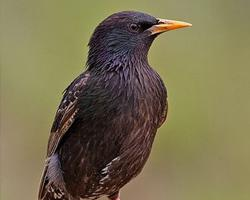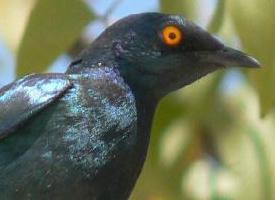
Poids et mesures
| Longueur | de 18 à 19 cm |
|---|
Description de l'animal
The Superb Starling (Lamprotornis superbus) is a small yet strikingly vibrant bird that graces the East African landscape with its iridescent plumage. Belonging to the family Sturnidae, which includes starlings and mynas, this species is renowned for its glossy, metallic sheen and sociable nature, often found in both wild and inhabited areas across Kenya, Ethiopia, Somalia, Tanzania, and Uganda.Measuring approximately 18 to 19 centimeters in length and weighing around 75 to 85 grams, the Superb Starling is relatively robust for its size. Its most remarkable feature is undoubtedly its plumage. The bird's body is predominantly a shimmering blue-green, with the wings and tail displaying a darker, almost black hue that contrasts sharply with the bright, metallic sheen of the rest of its body. The chest and belly are a rich chestnut color, separated from the blue-green by a conspicuous white band that adds to its striking appearance. Its eyes are surrounded by a distinctive white eye-ring, which further accentuates its vivid colors. Both males and females exhibit similar plumage, making them difficult to distinguish based solely on appearance.
The Superb Starling's diet is omnivorous, consisting of a wide variety of food sources. It feeds on insects, spiders, and other invertebrates, as well as fruits, seeds, and occasionally small vertebrates. This adaptability in diet contributes to its success in both rural and urban environments, where it can often be seen foraging on the ground in search of food, moving with agility and speed.
Social creatures by nature, Superb Starlings live in large flocks that can number in the hundreds. These flocks provide safety in numbers from predators, as well as increased efficiency in locating food sources. The birds are highly vocal, communicating with a range of calls that include whistles, trills, and chatters. Their vocalizations play a crucial role in social interactions within the flock, including mating rituals, establishing territories, and signaling alarm.
Breeding season for the Superb Starling varies depending on the geographic location but generally occurs during the rainy season when food is abundant. They are monogamous birds, with pairs often staying together for several breeding seasons. Nests are constructed in a variety of locations, including tree cavities, cliffs, and even buildings, using grass, leaves, and twigs. Females typically lay between 3 to 5 eggs, which are incubated for about 12 to 14 days. Both parents share in the duties of feeding and protecting the chicks until they are ready to fledge, usually within three weeks of hatching.
In addition to their aesthetic appeal, Superb Starlings play a significant role in their ecosystems. They help control insect populations and facilitate seed dispersal, contributing to the health and regeneration of their habitats. Despite facing threats from habitat destruction and the pet trade, the Superb Starling remains widespread and is classified as Least Concern by the International Union for Conservation of Nature (IUCN), indicating a stable population. Nonetheless, conservation efforts are important to ensure that these vibrant birds continue to thrive in their natural environments.
In conclusion, the Superb Starling, with its dazzling plumage and dynamic social structure, is a testament to the incredible diversity of the avian world. Its resilience and adaptability make it a common yet no less remarkable inhabitant of the East African landscape, captivating birdwatchers and nature enthusiasts alike.
Animaux similaires
Nouvelles photos d'animaux
Top 10 des animaux
- Dolphin gull (Leucophaeus scoresbii)
- Diana monkey (Cercopithecus diana)
- Moustached guenon (Cercopithecus cephus)
- Galápagos tortoise (Geochelone nigra complex)
- Japanese macaque (Macaca fuscata)
- Stone loach (Barbatula barbatula)
- Russian tortoise (Testudo horsfieldii)
- Greek tortoise (Testudo graeca)
- Common flying dragon (Draco volans)
- Vendace (Coregonus albula)


